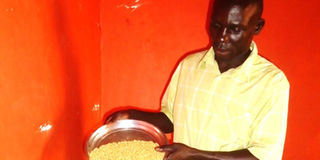Mill cash by adding value to millet, maize, soybean

Zubair Kawooya weighs soybeans. Photo by Fred Muzaale.
What you need to know:
- Zubair Kawooya uses millet, maize grains and soybean to process products such as porridge flour and bread flour, writes Fred Muzaale.
Zubair Kawooya a resident of Bukolooto village, Kayunga Town, in Kayunga District was a poor man three years ago.
He was previously a maize farmer and it is from selling dry maize grain that he derived his livelihood.
“I used to earn about Shs450,000 from my maize every season because I was being cheated by middlemen,” Kawooya, 43 years old recounts.
Numa processing plant
However, in 2014, Kawooya together with other farmers went for an education tour in Western Uganda.
During the tour, they visited Numa feeds in Bushenyi District. Numa Feeds Limited is a medium, rural-based agribusiness that adds value to rice, maize, soybean and millet by processing them into flour.
At Numa they were taken through the processes of making and mixing the flour and when Kawooya returned home, he tried to put into practice what he had learnt and seen.
Using the little savings he had made of Shs800,000 he bought the equipment and raw materials to use.
For the start he bought 50 kilogrammes each of maize, millet, rice and soybean.
He also bought a second hand weighing scale at Shs70,000, a polythene bag roll at Shs50,000 and Shs45,000 for branded labels.
He then turned two rooms of his residential house into a workplace.
He made four types of produce namely, soya millet flour which he makes by mixing soya and millet flour, rice flour, soya rice flour (mixture of rice and soya flour) soya flour which is also mixed with some maize flour. All products are mixed with maize flour except rice flour.
Adding value
Kawooya says he first sorts the grains to remove the stones and chaff. He then roasts them on a charcoal stove. He then mixes the components in different proportions, depending on their nutritional value.
He buys the grains from produce stores in Jinja and Mbale.
For instance, when he is going to make soy millet flour, he mixes them in a proportion of 40 kilogrammes for soybean, 30 kilogrammes for both millet and maize flour to make 100 kilogrammes.
“For all the produce, the ratio of soybean is higher than that of other components like maize or rice flour because soybean flour has a high nutritional value,” Kawooya says.
After doing the mixing, he takes them to a mill where he is charged Shs300 per kilogramme.
After the milling, he packages the produce in polythene bags of a half and one kilogramme. Then, he takes the products to the market using a motor-cycle and sometimes in a taxi.
Market
After fortifying the products into standards, Kawooya is able to tap into bigger markets. He mainly sells his products to supermarkets in Kampala, Jinja, Mukono, Kayunga and in eastern region mainly Busoga. In most cases he is always paid cash on delivery but in case there is no money he supplies the products on credit and gets the money after one week. He also sells to individuals who get them from his home.
Kawooya’s biggest challenges lies in the ever increasing prices of the raw materials (grains). This he says makes planning very hard as he is not sure of how much he is going to buy or sell his products.
Although he grows some of the raw materials, he cannot have them all the time so he resorts to buying from other farmers and traders.
Also, he says he has limited market for his products as some super markets refuse to buy them since they are not yet certified by Uganda bureau of standards.
Kawooya says he also lacks transport means for taking his products to the market faster and in a safe way.




